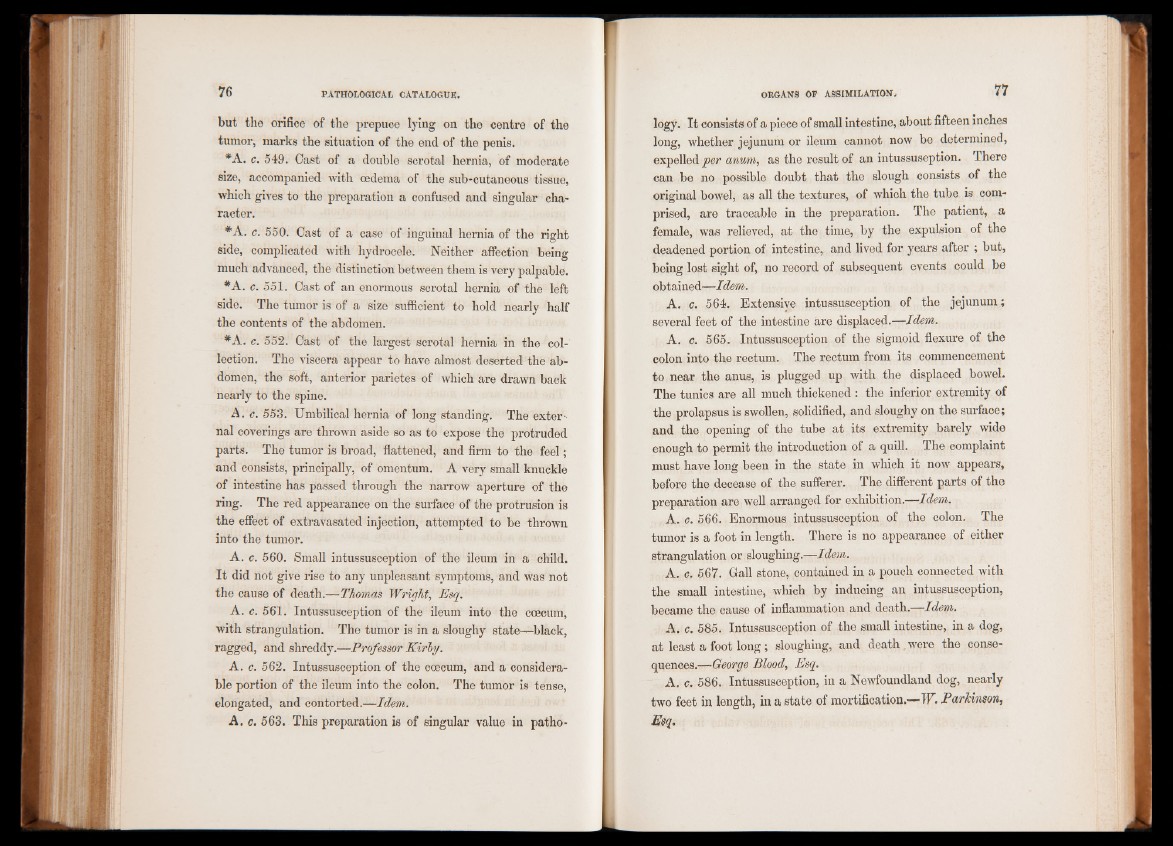
but the orifice of the prepuce lying on the centre of the
tumor, marks the situation of the end of the penis.
*A. c. 549. Oast of a double scrotal hernia, of moderate
size, accompanied with oedema of the sub-cutaneous tissue,
which gives to the preparation a confused and singular character.
*A. c. 550. Oast of a case of inguinal hernia of the right
side, complicated with hydrocele. Neither affection being
much advanced, the distinction between them is very palpable.
*A. e. 551. Oast of an enormous scrotal hernia of the left
side. The tumor is of a size sufficient to hold nearly half
the contents of the abdomen.
*A. c. 552. Oast of the largest scrotal hernia in the collection.
The viscera appear to have almost deserted the abdomen,
the soft, anterior parietes of which are drawn back
nearly to the spine.
A. c. 553. Umbilical hernia of long standing. The external
coverings are thrown aside so as to expose the protruded
parts. The tumor is broad, flattened, and firm to the feel ;
and consists, principally, of omentum. A very small knuckle
of intestine has passed through the narrow aperture of the
ring. The red appearance on the surface of the protrusion is
the effect of extravasated injection, attempted to be thrown
into the tumor.
A. c. 560. Small intussusception of the ileum in a child.
It did not give rise to any unpleasant symptoms, and was not
the cause of death.—Thomas Wright, Esq.
A. c. 561. Intussusception of the ileum into the cæcum,
with strangulation. The tumor is in a sloughy state—black,
ragged, and shreddy.—Professor Kirby.
A. c. 562. Intussusception of the cæcum, and a considerable
portion of the ileum into the colon. The tumor is tense,
elongated, and contorted.—Idem.
A. c. 563. This preparation is of singular value in pathology.
It consists of a piece of small intest ine, about fifteen inches
long, whether jejunum or ileum cannot now be determined,
expelled per anum, as the result of an intussuseption. There
can be no possible doubt that the slough consists of the
original bowel, as all the textures, of which the tube is comprised,
are traceable in the preparation. The patient, a
female, was relieved, at the time, by the expulsion of the
deadened portion of intestine, and lived for years after ; but,
being lost sight of, no record of subsequent events could be
obtained—Idem.
A. c. 564. Extensive intussusception of the jejunum;
several feet of the intestine are displaced.—Idem.
A. c. 565. Intussusception of the sigmoid flexure of the
colon into the rectum. The rectum from its commencement
to near the anus, is plugged up with the displaced bowel.
The tunics are all much thickened : the inferior extremity of
the prolapsus is swollen, solidified, and sloughy on the surface;
and the opening of the tube at its extremity barely wide
enough to permit the introduction of a quill. The complaint
must have long been in the state in which it now appears,
before the decease of the sufferer. The different parts of the
preparation are well arranged for exhibition.—Idem.
A. c. 566. Enormous intussusception of the colon. The
tumor is a foot in length. There is no appearance of either
strangulation or sloughing.—Idem.
A. c. 567. Grail stone, contained in a pouch connected with
the small intestine, which by inducing an intussusception,
became the cause of inflammation and death.—Idem.
A. c. 585. Intussusception of the small intestine, in a dog,
at least a foot long; sloughing, and death .were the consequences.—
George Blood, Esq.
A. c. 586. Intussusception, in a Newfoundland dog, nearly
two feet in length, in a state of mortification.—-IF. Parkinson,
Esq.